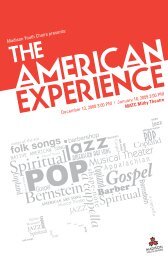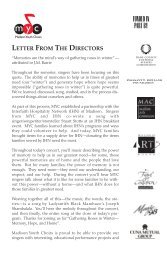Songs for a Small Planet (May 2009) - Madison Youth Choirs
Songs for a Small Planet (May 2009) - Madison Youth Choirs
Songs for a Small Planet (May 2009) - Madison Youth Choirs
Create successful ePaper yourself
Turn your PDF publications into a flip-book with our unique Google optimized e-Paper software.
Little Birch Tree<br />
Russian Folk Song<br />
Arranged by Sue E. Bohlin<br />
The birch is the national tree of Russia and a national symbol of Estonia and Finland.<br />
With its white bark and delicate leaves, the silver birch dots the landscape of this region.<br />
There are numerous references to the birch tree in the literature, music, art, and folklore<br />
of these cultures. The beloved melody of this folk song about the birch tree can be heard<br />
in the fourth movement of Symphony No. 4 by the famous Russian composer Peter Ilyich<br />
Tchaikovsky.<br />
Birches are versatile trees. The sap, bark, leaves, wood, twigs, and roots have been used<br />
<strong>for</strong> food, construction materials, medicines, lubricants, art objects, and drums. And as<br />
alluded to in this song, birch wood has been used <strong>for</strong> pitched musical instruments: the<br />
flute, and the famous Russian triangular-shaped stringed instrument, the balalaika.<br />
In this arrangement, the accompaniment attempts to capture the exciting movement of<br />
the dancing leaves by the juxtaposition of the two-bar sixteenth note pattern in the piano<br />
with the three-bar contour of the melody, and the addition of a five-beat pattern in the middle<br />
of the piece. (Program notes from the arranger)<br />
Escape at Bedtime Alice Parker (b. 1925)<br />
Text by Robert Louis Stevenson (1850-1894)<br />
A child’s first sight of a clear night sky is an enduring memory. Robert Louis Stevenson’s<br />
poem Escape at Bedtime tells the story of a child who sneaks out of bed and escapes<br />
outdoors to view the glorious stars be<strong>for</strong>e being found and returned to bed. The poem<br />
comes from A Child’s Garden of Verses (1885), a collection of poetry written <strong>for</strong> children<br />
and from a child’s point of view. Struggling with poor health throughout his life, Stevenson<br />
was inspired to create this series of children’s poems to reflect the happiest times of<br />
his life.<br />
Ae Fond Kiss<br />
Traditional Scottish Melody<br />
Arranged by Lee R. Kesselman<br />
Ae Fond Kiss is a traditional Scottish melody that tempers the sadness of parting with the<br />
joy of friendship and love. Choraliers singers reflected on someone or something they had<br />
to part with but still treasure. Robert Burns (1759-1796), poet and lyricist, is widely regarded<br />
as the national poet of Scotland and is celebrated worldwide. He wrote this<br />
poem and song of farewell to Agnes McLehose, known to him as Clarinda, on her departure<br />
overseas.




